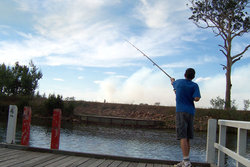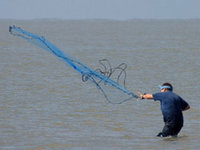Fishing
|
|
| Contents |
Commercial fishing
Fiskebåt_i_Simrishamn.jpg
Main article Fishing industry
Commercial fishing is a very dangerous occupation lives can be lost but much money can be gained in the process. Fishing provides a large quantity of food to many countries around the world, but those who pursue it as an industry must often pursue fish far into the ocean under bad conditions. Commercial fishermen harvest almost all aquatic species, from tuna, cod and salmon to shrimp, lobster, clams, and squid. Commercial fishing methods have become very efficient using large nets and sea-borne processing factories. Many new restrictions are often integrated with varieties of fishing allocation schemes, and international treaties that have sought to limit the yearly fishing effort.
Commercial fish raising in the forms of aquaculture and Mari culture supplement the free-range catch of fish.
Recreational fishing
Recreational fishing is generally done with a (fishing rod) and line with any number of Lures or bait this is a technique known as angling. Laws exist that limit the number of lines and hooks that one fisherman can use and the number of fish that can be harvested. Popular sport species of freshwater fish include Black Bass (Black Bass includes the entire range of Bass fish), Pike, Muskellunge, Perch, Trout, Salmon, and Sunfish. Saltwater fish that are caught for sport include Swordfish, Marlin, Tuna, ect.
Laws generally prohibit the use of nets and catching fish with hooks not in the mouth. However some species can be taken with nets for bait and a few for food. (Non-sport) fish considered of less value can sometimes be taken by multiple methods like snagging, bow and arrow, or even gun because they are seen as competing with more valuable fish.
Recreational fishing laws also include other aquatic species, such as frogs and turtles.
Sport fishing is a recent phenomenon of recreational fishing where fishermen compete for prizes based on the total weight of fish caught in a time limit. This sport evolved from local fishing contests into a large competition circuit in the U.S.A. where professional fishermen can compete and be supported by professional endorsements, and other large-scale tournaments around the world.
Fishing Techniques for Fresh Waters in Temperate Climes
Removing_the_hook.jpg
When fishing, keep at some distance from the surface of the water, so that your shadow may not fall upon the water, and frighten away the fish; to avoid the same consequences, do not indulge in laughter or loud conversation.
If the water is still, use smaller pieces of bait; if there is a strong current, use large pieces; do this quietly and cautiously because fish can feel vibrations around them and actually see out of the water and recognize forms of people trying to catch them, fish are getting smarter.
When the wind blows right across the water, fish with your back to the wind, as you will not only be able to throw your line better, but the fish will be on that side, attracted by the flies and other natural bait which the wind will blow into it.
The common Flat Worm is universal bait for fresh water angling. They can be found in dark damp areas or at night when they surface. They are light sensitive so if they feel heat from a flashlight the will sink into the earth. The common white grub is used successfully in trout fishing, they are found in fresh ploughed earth, and under old stumps, decaying foliage, etc. Grasshopper is also good for trout in their season, although trout or salmon spawn will attract trout quicker than any other possible bait.
Live bait consists of living things that make their way into the environment of the fish and are then eaten by them. Ponds of these fish are kept by those who furnish baits, and by some habitual sportsmen.
Frog are ideal bait for pickerel they can be used whole, in cases where the fisherman uses the hind legs only, they should be skinned.
Brief Note on Saltwater Fishing
For saltwater fishing, shrimp is the leading bait. The shedder crab, in its season, is most effective, particularly for striped bass. The soft shell clam, cut in small pieces, is good bait for many kinds of sea fish.
Preparing baits
We have before said that salmon roe was ideal bait for trout. The roe of large trout or salmon trout is just as effective. These are tempting baits for many other fresh water fish besides the trout. Old fishermen preserve it as follows: First put it in warm water, not hot enough to scald much - then separate the membranous films - rinse it well in cold water and hang it up to dry. The next day salt it with two ounces of salt and a quarter of an ounce of saltpeter to the pound of roe. Let it stand another day and then spread it to dry. When it becomes stiff put it in small pots, pouring over each some melted mutton tallow. You can then use a pot of preparation, as you may want it for bait. This is ideal for trout, and indeed for almost any fry in fresh water.
Catch and Release
Catch-and-release fishing is increasingly practiced especially by fly fishermen, as well as spin and bait casting fishermen, to increase conservation and to protect rare fish such as marlin. The practice is however disputed as it by some is considered unethical to perform painful actions to the fish for fun and not for the reason of food production. Because of this, catch-and-release practice is illegal in Norway.
Collection of Live Fish
Live fish collection uses many methods. Some are better for the environment, the mortality of the fish, and the overall quota of fishes. Some are not. One very destructive method of catching live fish for aquarium collection is cyanide fishing. (See also cyanide.)
For more information:
- The Coral Reef Alliance: [1] (http://www.coralreefalliance.org/)
- EcoViability: [2] (http://ecovitality.org/cyanide.htm)
Fishes can also be collected in ways that do not injure them (such as in a seine net), for observation and study or for keeping in Aquarium.
There are several organization that are devoted to the improving methods of collection, transport, export and farming of wild and domesticated live fish, and usually freshwater or marine tropical fish.
For more information:
- Marine Aquarium Council [3] (http://www.marinecouncil.org)
- Reef Central [4] (http://reefcentral.com/)
Live fish are also collected for importing and exporting in today's international live food fish trade. Some modern seafood restaurants, especially those in Asian countries where seafood is a significant part of their people’s diet, choose to keep live fish in aquaria for display or for cultural beliefs. One such belief is that keeping a live tank full of colorful fish or other organisms, specifically red and orange in color, bring good luck and prosperity (Bean, Jan 2003 (http://www.findarticles.com/p/articles/mi_m3723/is_1_15/ai_98336137#continue)) to the restaurant's business. In fact, in Chinese, the pronunciation for "fish" is a homonym for “abundance” or “affluence”. (Lip, 83) The majority of live fish kept at seafood restaurants, however, are desired for the freshness of the seafood, being killed only immediately before being cooked. Suiting customer preference, this practice makes the seafood higher in quality and better in taste. The prevalence of cultural beliefs and consumer standards helps to drive the demand for the live food fish trade. Hong Kong, for example, imported an estimated 17,000 tons of life food fish in 2000. This brought the value of their live food fish trade industry to US$400 million as reported by the World Resources Institute (http://marine.wri.org/pubs_content_text.cfm?ContentID=645). It is also stated that most of the fish exported to the Hong Kong market were cultured and the majority of these captures did not involve poisons (from Australia and most of the Pacific) but controversy and dispute looms over the use of cyanide fish collection in some parts of Southeast Asia, particularly Indonesia and the Philippines.
See also:
- Clam digging
- Fishery
- Fishfinder
- Fishing hook
- Fishing line
- Fishing lure
- Fishing reel
- Fishing rod
- Fly fishing
- List of fishing topics
- Long-line fishing
- Noodling
- Overfishing
- Sinker
- Trawling
- Trolling for fish
References
- Bean, Ralph, U.S. Department of Agriculture, AgExporter, "In China, fish means prosperity - high prospects for imports" (http://www.findarticles.com/p/articles/mi_m3723/is_1_15/ai_98336137#continue), May 18, 2005
- Lip, Evelyn, Chinese Practices and Beliefs, CA: Heian International Publishing, May 2002
External links
- How to fish (http://www.publicbookshelf.com/public_html/Boys_Own_Book_of_Outdoor_Sports/) taken from the Boy's Own Book of Outdoor Sports (early 1900s)
- Effects of Water Quality (http://www.epa.gov/owow/monitoring/nationswaters/) - the ability to find fish will ultimately rest on the water quality.
- Water Quality relationship (http://www.sierraclub.org/cleanwater/waterquality/) - even if the fish survive can they be consumed safely?
- Ice Fishing Safety (http://www.surviveoutdoors.com/reference/icefishing.asp)
- It's How you Wiggle Your Worm (http://www.westforthsports.com/index.asp?PageAction=Custom&ID=15) - basic techniques for fishing the plastic worm.
- Spearfishing (http://www.spearfishingworld.net) - spearfishing portalca:Pesca
cy:Pysgota de:Angeln (Fischfang) es:Pesca fr:Pêche (halieutique) gl:Pesca he:דיג io:Pesko nl:Vissen (sport) ja:釣り sv:Fiske zh:&钓鱼


